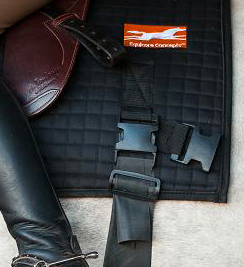 |
| Horse wearing the modified saddle pad with abdominal resistance band attached; the clip for the hindquarters band can also be seen. |
Core strength training for horses has been a key criteria for developing equine athletes with the necessary condition and muscle develop to sustain advanced gaits and collected movements. Even if a horse has great conformation and appears to have the natural talent to excel, sufficient core body strength is required for sustained collected work.
In recent years, emphasis on the rehabilitation of injured horses has begun to emphasis the critical need for re-establishing core strength after an extended layoff or an injury.
Many training or rehabilitation programs and products aim to improve core muscle strength to increase dynamic stability. Until now however, there has been little supporting evidence on the efficacy of these programs.
New research at the Royal Veterinary College in the United Kingdom found that the use of a specific system of Equiband™elastic resistance bands is extremely effective in increasing dynamic stability of the horse in trot.
The research proved that horse owners can use the elastic band method to prevent injuries as well as overcome them. They are easily accessible to horse owners.
 |
Horse ridden with the hindquarter
band. (RVC photo) |
A statistical model was used that investigated the effect of band usage and the effect of time, as well as whether the horse moved in-hand or on the left or right rein on the lunge. Back movement parameters were calculated from a total of 3,215 strides (25 to 89 strides per condition) at the two times points (week one and week four), with and without the use of the exercise bands.
 |
Closeup detail of Equicore system saddle pad
with buckles for both belly and hindquarter bands. (RVC photo) |
The research was conducted by Dr-Ing Thilo Pfau, Senior Lecturer in Bio-Engineering at the RVC; Professor Renate Weller, Professor in Comparative Imaging and Biomechanics at the RVC; Victoria Simons, an RVC veterinary student; Nicole Rombach, PhD, of Equinology Inc. in California; and Narelle Stubbs, PhD, from the Department of Equine Sports Medicine, Tierklinik Lűsche, Germany and Napoli Slovak Equestrian Club, Samorin, Slovakia.
 |
Dr-Ing Thilo Pfau of the Royal
Veterinary College (RVC photo) |
Thilo Pfau said of the project: “Until now there has been little supporting evidence on the effect of training and rehabilitation programs in preventing and/or treating lameness and back problems in horses.
"The system we tested is easy to use during the normal exercise routine of a horse, meaning it can be applied to horses of any discipline. It also takes very little time to apply to the horse, considering all it entails is attaching the bands to a modified saddle pad, and it can be used during ridden exercise.”
To learn more about the RVC's research on elastic resistance bands:
Pfau, T., Simons, V., Rombach, N., Stubbs, N. and Weller, R., Effect of a 4-week elastic resistance band training regimen on back kinematics in horses trotting in-hand and on the lunge. Equine Vet J. Accepted Author Manuscript. doi:10.1111/evj.12690 (Article beyond abstract requires subscription or library sign-in.)
Simons, V., Weller, R., Stubbs, N.C., Rombach, N. and Pfau, T. (2015), Objective Assessment of Back Kinematics and Movement Asymmetry in Horses: Effect of Elastic Resistance Band Training. Equine Vet J, 47: 11. doi:10.1111/evj.12486_23 (The 2015 BEVA Clinical Research Abstracts entire document is free to view.)
Information for this article courtesy of the Royal Veterinary College.
© Fran Jurga and Hoofcare Publishing; Fran Jurga's Hoof Blog is the news service for Hoofcare and Lameness Publishing. Please, no re-use of text or images on other sites or social media without permission--please link instead. (Please ask if you need help.) The Hoof Blog may be read online at the blog page, checked via RSS feed, or received via a headlines-link email (requires signup in box at top right of blog page). Use the little envelope symbol below to email this article to others. The "translator" tool in the right sidebar will convert this article (roughly) to the language of your choice. To share this article on Facebook and other social media, click on the small symbols below the labels. Be sure to "like" the Hoofcare and Lameness Facebook page and click on "get notifications" under the page's "like" button to keep up with the hoof news on Facebook.
Follow Hoofcare + Lameness on Twitter: @HoofBlog
Read this blog's headlines on the Hoofcare + Lameness Facebook Page
Disclosure of Material Connection: The Hoof Blog (Hoofcare Publishing) has not received any direct compensation for writing this post. Hoofcare Publishing has no material connection to the brands, products, or services mentioned, other than products and services of Hoofcare Publishing. I am disclosing this in accordance with the Federal Trade Commission’s 16 CFR, Part 255: Guides Concerning the Use of Endorsements and Testimonials in Advertising.


